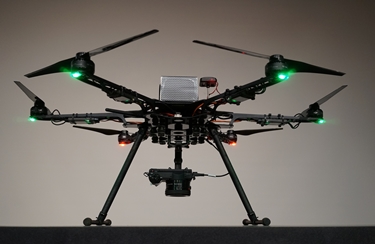NEWS
Interdisciplinary research leading to new UAV technologies
— P9000 customizable UAV provides industries with new mapping, imaging opportunities —
Faculty from a number of academic disciplines at Louisiana Tech University are working together to develop new and innovative technologies in unmanned aerial vehicles (UAV) that could impact industries from public safety to forestry to oil and gas exploration.
Wesley Palmer, instructor of geographic information systems (GIS) in Louisiana Tech’s School of Forestry and supervisor of its Spatial Data Lab, is collaborating with faculty in Louisiana Tech’s electrical engineering department to create higher endurance UAVs that have significantly increased flight times and increased payload capacities. Palmer has teamed with Dr. Rastko Selmic, professor of electrical engineering and director of the Micro-Aerial Vehicles & Sensor Networks (MAVSeN) Laboratory at Louisiana Tech, to develop progressive vehicles that will allow researchers to capture larger geographic areas and conduct multiple trials without needing to land.
“The majority of the commercial off-the-shelf UAVs that are available have limited flight times of less than 25 minutes and limited payload capabilities,” said Palmer. “We wanted to develop a UAV platform that could fly for a longer period of time, carrying a mid-sized payload. That’s what led to the development of the P9000.”
The P9000, a customizable autonomous UAV, can fly for up to an hour, depending on payload, and can be used for a variety of geospatial mapping applications, covering a large area or a long pipeline corridor with its extended flight times. It is also swarm capable and GPS enabled, and built from an innovative carbon and aluminum frame developed by Selmic and his team of graduate students in the MAVSeN lab.
“For the P9000, we utilized an open source flight controller which will allow for custom programming to be executed on the UAV which can expand performance and functionality,” Palmer said. “We used efficient motors and propellers to minimize power consumption. Lightweight aluminum and carbon fiber materials are integrated into the frame design to keep the platform light yet extremely strong, and custom carbon fiber centerplate was designed and manufactured in Louisiana Tech Thingery.”
The Thingery at Louisiana Tech is a highly-interdisciplinary and creative collaboration space where faculty, staff, students and even members of the local community are encouraged to share innovative ideas and work together to create new products, services, projects and activities.
Palmer says UAVs can be very useful tools for a wide variety of industries and applications. Law enforcement agencies are using UAVs for situational awareness and surveillance applications. Foresters are using UAVs to gather data about the forest to make better management decisions. UAVs are also used in the oil and gas industry to map pipelines and well pad locations.
In the GIS and mapping profession, UAVs are essential in gathering remotely-sensed imagery for a fraction of the cost compared to satellite or manned aircraft data capture. Farmers and agricultural science professionals utilize data captured from UAVs to monitor crops to produce better yields.
In experimenting with and developing new UAVs, sensors and data products, Palmer says students at Louisiana Tech are actively engaged and contributing, along with the faculty, throughout the process.
“We take what we have learned in the lab and integrate those cutting-edge ideas into the classroom,” explains Palmer. “UAV research, development and student learning is truly a multi-disciplinary effort here at Louisiana Tech. Each area brings a unique set of skills and background to the collaborative effort, and together we gain new perspectives on how we move forward with UAV research, education and service at Louisiana Tech.”
Palmer says the goal of the P9000 project was to establish a UAV platform with extended endurance by more than doubling the working flight time of most commercially available UAVs in its class.
“Now that we have achieved that goal and have a customizable platform with optimized endurance, we can put the P9000 to work in testing cameras and sensors,” said Palmer. “At the end of the day, a UAV is a tool to perform some type of task. We can leverage this new tool to execute current and future research projects.”
